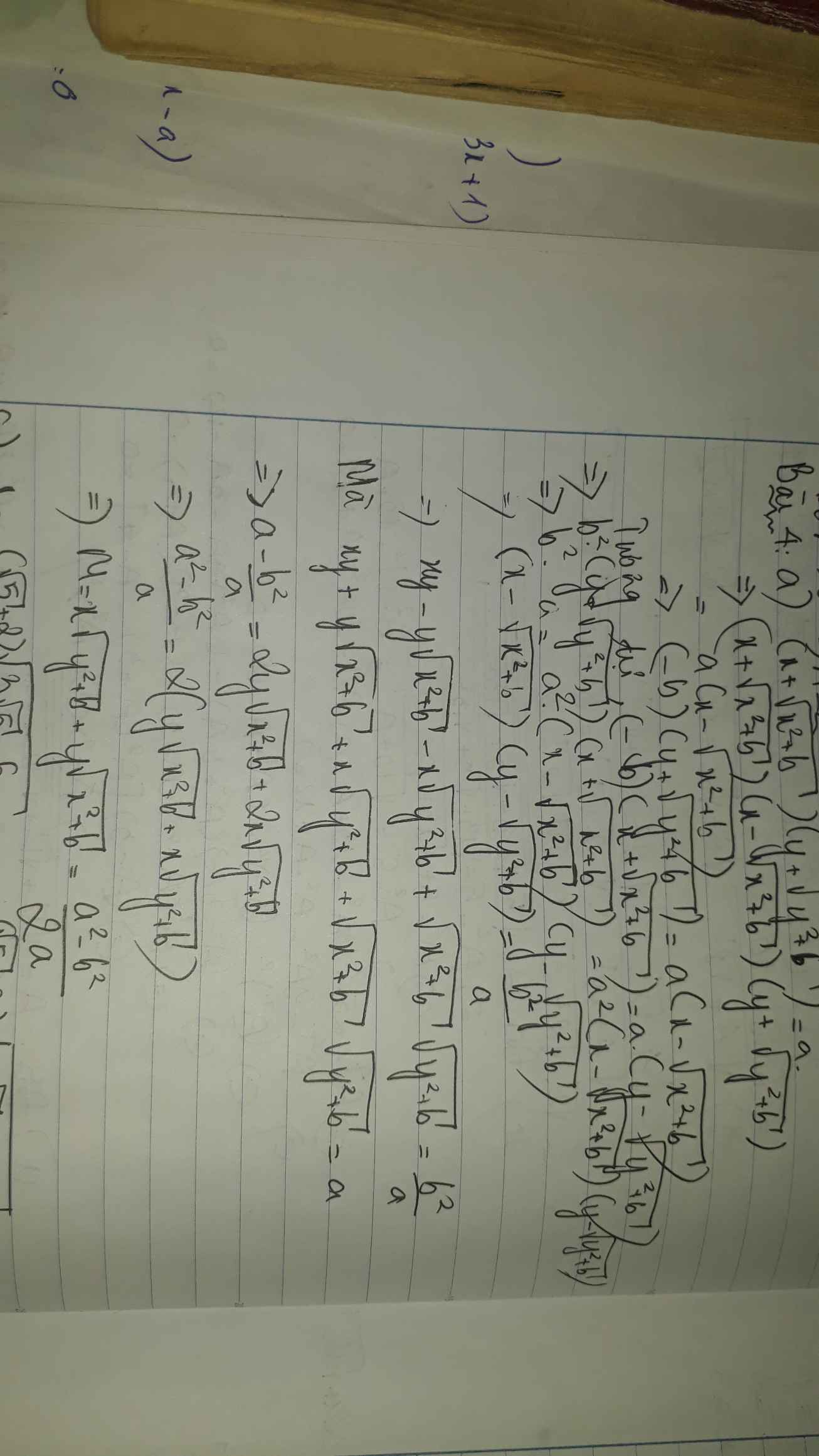
Hãy nhập câu hỏi của bạn vào đây, nếu là tài khoản VIP, bạn sẽ được ưu tiên trả lời.


a, ĐK: \(x,y\ge0\)
\(hpt\Leftrightarrow\left\{{}\begin{matrix}\dfrac{3\sqrt{y}}{\sqrt{x+3}-\sqrt{x}}=3\\\sqrt{x}+\sqrt{y}=x+1\end{matrix}\right.\)
\(\Leftrightarrow\left\{{}\begin{matrix}\sqrt{x}+\sqrt{y}=\sqrt{x+3}\\\sqrt{x}+\sqrt{y}=x+1\end{matrix}\right.\)
\(\Rightarrow\sqrt{x+3}=x+1\)
\(\Leftrightarrow x+3=x^2+2x+1\)
\(\Leftrightarrow\left(x-1\right)\left(x+2\right)=0\)
\(\Leftrightarrow\left[{}\begin{matrix}x=1\\x=-2\left(l\right)\end{matrix}\right.\)
Thay \(x=1\) vào hệ phương trình đã cho ta được \(y=1\)
Vậy pt đã cho có nghiệm \(x=y=1\)
b, \(hpt\Leftrightarrow\left\{{}\begin{matrix}\left(x+\dfrac{1}{2}\right)^2=\left(y+\dfrac{1}{2}\right)^2\\x^2+y^2=3\left(x+y\right)\end{matrix}\right.\)
\(\Leftrightarrow\left\{{}\begin{matrix}\left[{}\begin{matrix}x=y\\x+y=-1\end{matrix}\right.\\x^2+y^2=3\left(x+y\right)\end{matrix}\right.\)
\(\Leftrightarrow\left[{}\begin{matrix}\left\{{}\begin{matrix}x=y\\x^2-3x=0\end{matrix}\right.\left(1\right)\\\left\{{}\begin{matrix}x+y=-1\\x^2+y^2=-3\end{matrix}\right.\left(vn\right)\end{matrix}\right.\)
\(\left(1\right)\Leftrightarrow\left[{}\begin{matrix}x=y=3\\x=y=0\end{matrix}\right.\)
Vậy ...

a) \(x^3-4x^2-5x+6=\sqrt[3]{7x^2+9x-4}\)
\(\Leftrightarrow-7x^2-9x+4+x^3+3x^2+4x+2=\sqrt[3]{7x^2+9x-4}\)
\(\Leftrightarrow-\left(7x^2+9x-4\right)+\left(x+1\right)^3+x+1=\sqrt[3]{7x^2+9x-4}\) (*)
Đặt \(\sqrt[3]{7x^2+9x-4}=a;x+1=b\)
Khi đó (*) \(\Leftrightarrow-a^3+b^3+b=a\)
\(\Leftrightarrow\left(b-a\right).\left(b^2+ab+a^2+1\right)=0\)
\(\Leftrightarrow b=a\)
Hay \(x+1=\sqrt[3]{7x^2+9x-4}\)
\(\Leftrightarrow\left(x+1\right)^3=7x^2+9x-4\)
\(\Leftrightarrow x^3-4x^2-6x+5=0\)
\(\Leftrightarrow x^3-4x^2-5x-x+5=0\)
\(\Leftrightarrow\left(x-5\right)\left(x^2+x-1\right)=0\)
\(\Leftrightarrow\left[{}\begin{matrix}x=5\\x=\dfrac{-1\pm\sqrt{5}}{2}\end{matrix}\right.\)

a, \(\left\{{}\begin{matrix}x+y=4\\\left(x^2+y^2\right)\left(x^3+y^3\right)=280\end{matrix}\right.\)
\(\Leftrightarrow\left\{{}\begin{matrix}x+y=4\\\left(x^2+y^2\right)\left(x^2+y^2-xy\right)=70\end{matrix}\right.\)
\(\Leftrightarrow\left\{{}\begin{matrix}x+y=4\\\left(16-2xy\right)\left(16-3xy\right)=70\end{matrix}\right.\)
\(\Leftrightarrow\left\{{}\begin{matrix}x+y=4\\3x^2y^2-40xy+93=0\end{matrix}\right.\)
\(\Leftrightarrow\left\{{}\begin{matrix}x+y=4\\\left[{}\begin{matrix}xy=\dfrac{31}{3}\\xy=3\end{matrix}\right.\end{matrix}\right.\)
TH1: \(\left\{{}\begin{matrix}x+y=4\\xy=3\end{matrix}\right.\Leftrightarrow\left[{}\begin{matrix}\left\{{}\begin{matrix}x=1\\y=3\end{matrix}\right.\\\left\{{}\begin{matrix}x=3\\y=1\end{matrix}\right.\end{matrix}\right.\)
TH2: \(\left\{{}\begin{matrix}x+y=4\\xy=\dfrac{31}{3}\end{matrix}\right.\)
Phương trình này vô nghiệm
Vậy hệ đã cho có nghiệm \(\left(x;y\right)\in\left\{\left(1;3\right);\left(3;1\right)\right\}\)
b, ĐK: \(xy>0\)
\(\left\{{}\begin{matrix}\sqrt{\dfrac{2x}{y}}+\sqrt{\dfrac{2y}{x}}=3\\x-y+xy=3\end{matrix}\right.\)
\(\Leftrightarrow\left\{{}\begin{matrix}\dfrac{2x}{y}+\dfrac{2y}{x}+4=9\\x-y+xy=3\end{matrix}\right.\)
\(\Leftrightarrow\left\{{}\begin{matrix}2\left(x^2+y^2\right)=5xy\\x-y+xy=3\end{matrix}\right.\)
\(\Leftrightarrow\left\{{}\begin{matrix}\left(2x-y\right)\left(x-2y\right)=0\\x-y+xy=3\end{matrix}\right.\)
\(\Leftrightarrow\left\{{}\begin{matrix}\left[{}\begin{matrix}2x=y\\x=2y\end{matrix}\right.\\x-y+xy=3\end{matrix}\right.\)
TH1: \(\left\{{}\begin{matrix}y=2x\\x-y+xy=3\end{matrix}\right.\)
\(\Leftrightarrow\left\{{}\begin{matrix}y=2x\\2x^2-x-3=0\end{matrix}\right.\)
\(\Leftrightarrow\left\{{}\begin{matrix}y=2x\\\left(x+1\right)\left(2x-3\right)=0\end{matrix}\right.\)
\(\Leftrightarrow\left[{}\begin{matrix}\left\{{}\begin{matrix}y=-2\\x=-1\end{matrix}\right.\\\left\{{}\begin{matrix}y=3\\x=\dfrac{3}{2}\end{matrix}\right.\end{matrix}\right.\)
TH2: \(\left\{{}\begin{matrix}x=2y\\x-y+xy=3\end{matrix}\right.\)
\(\Leftrightarrow\left\{{}\begin{matrix}x=2y\\2y^2+y-3=0\end{matrix}\right.\)
\(\Leftrightarrow\left[{}\begin{matrix}\left\{{}\begin{matrix}x=2\\y=1\end{matrix}\right.\\\left\{{}\begin{matrix}x=3\\y=\dfrac{3}{2}\end{matrix}\right.\end{matrix}\right.\)
Vậy ...

Một dạng rất uen thuộc của lượng giác là tìm gtnn,ln bằng cách đặt ẩn là sinx và cosx
\(x^2+y^2-2x-4y+4=0\Leftrightarrow\left(x-1\right)^2+\left(y-2\right)^2=1\)
\(\left\{{}\begin{matrix}\sin\alpha=x-1\\\cos\alpha=y-2\end{matrix}\right.\)
\(\Rightarrow\left\{{}\begin{matrix}x=\sin\alpha+1\\y=\cos\alpha+2\end{matrix}\right.\)
\(\Rightarrow P=\left(\sin\alpha+1\right)^2-\left(\cos\alpha+2\right)^2+2\sqrt{3}\left(\sin\alpha+1\right)\left(\cos\alpha+2\right)-2\left(\sin\alpha+1\right)-4\sqrt{3}\left(\sin\alpha+1\right)-4\left(\cos\alpha+2\right)-2\sqrt{3}\left(\cos\alpha+2\right)-3+4\sqrt{3}\)
\(\Leftrightarrow P=\sin^2\alpha-\cos^2\alpha+2\sqrt{3}\sin\alpha\cos\alpha-16\)
Ta đưa về góc 2 alpha để dễ xét
\(\Leftrightarrow P=\frac{1-\cos2\alpha}{2}-\frac{\cos2\alpha+1}{2}+\sqrt{3}\sin2\alpha-16\)
\(\Rightarrow P=\sqrt{3}\sin2\alpha-\cos2\alpha-16\)
\(P=2\sin\left(2\alpha-\frac{\pi}{6}\right)-16\)
\(\Rightarrow2.\left(-1\right)-16\le P\le2.1-16\)
\(\Rightarrow\left\{{}\begin{matrix}P_{min}=-18;"="\Leftrightarrow2\alpha-\frac{\pi}{6}=-\frac{\pi}{2}+k2\pi\\P_{max}=-14;"="\Leftrightarrow2\alpha-\frac{\pi}{6}=\frac{\pi}{2}+k2\pi\end{matrix}\right.\)
Bạn tự thay vô x và y để xét dấu bằng nhé

Công thức tổng quát:

Áp dụng vào bài toán thì ta có Q=0.75

a: ĐKXĐ: \(\left(x+2\right)\left(x+3\right)>=0\)
=>\(\left[{}\begin{matrix}x>=-2\\x< =-3\end{matrix}\right.\)
\(y=\sqrt{\left(x+2\right)\left(x+3\right)}=\sqrt{x^2+5x+6}\)
=>\(y'=\dfrac{\left(x^2+5x+6\right)'}{2\sqrt{x^2+5x+6}}=\dfrac{2x+5}{2\sqrt{x^2+5x+6}}\)
y'>0
=>\(\dfrac{2x+5}{2\sqrt{x^2+5x+6}}>0\)
=>2x+5>0
=>\(x>-\dfrac{5}{2}\)
Kết hợp ĐKXĐ, ta được: x>=-2
Đặt y'<0
=>2x+5<0
=>2x<-5
=>\(x< -\dfrac{5}{2}\)
Kết hợp ĐKXĐ, ta được: x<=-3
Vậy: Hàm số đồng biến trên \([-2;+\infty)\) và nghịch biến trên \((-\infty;-3]\)
b: ĐKXĐ: \(\dfrac{2x+1}{x-3}>=0\)
=>\(\left[{}\begin{matrix}x>3\\x< =-\dfrac{1}{2}\end{matrix}\right.\)
\(y=\sqrt{\dfrac{2x+1}{x-3}}\)
=>\(y'=\dfrac{\left(\dfrac{2x+1}{x-3}\right)'}{2\sqrt{\dfrac{2x+1}{x-3}}}\)
=>\(y'=\dfrac{\dfrac{\left(2x+1\right)'\left(x-3\right)-\left(2x+1\right)\left(x-3\right)'}{\left(x-3\right)^2}}{2\sqrt{\dfrac{2x+1}{x-3}}}\)
=>\(y'=\dfrac{\dfrac{2\left(x-3\right)-2x-1}{\left(x-3\right)^2}}{2\sqrt{\dfrac{2x+1}{x-3}}}\)
\(=-\dfrac{\dfrac{7}{\left(x-3\right)^2}}{2\sqrt{\dfrac{2x+1}{x-3}}}< 0\forall x\) thỏa mãn ĐKXĐ, trừ x=-1/2 ra
=>Hàm số luôn đồng biến trên \(\left(3;+\infty\right);\left(-\infty;-\dfrac{1}{2}\right)\)
c:
ĐKXĐ: x>=-3
\(y=\left(x+1\right)\sqrt{x+3}\)
=>\(y'=\left(x+1\right)'\cdot\sqrt{x+3}+\left(x+1\right)\cdot\sqrt{x+3}'\)
=>\(y'=\sqrt{x+3}+\left(x+1\right)\cdot\dfrac{\left(x+3\right)'}{2\sqrt{x+3}}\)
=>\(y'=\sqrt{x+3}+\dfrac{x+1}{2\sqrt{x+3}}\)
=>\(y'=\dfrac{2x+6+x+1}{2\sqrt{x+3}}=\dfrac{3x+7}{2\sqrt{x+3}}\)
Đặt y'>0
=>3x+7>0
=>x>-7/3
Kết hợp ĐKXĐ, ta được: x>-7/3
Đặt y'<0
3x+7<0
=>x<-7/3
Kết hợp ĐKXĐ, ta được: \(-3< x< -\dfrac{7}{3}\)
Vậy: Hàm số đồng biến trên \(\left(-\dfrac{7}{3};+\infty\right)\) và nghịch biến trên \(\left(-3;-\dfrac{7}{3}\right)\)
d: \(y=\dfrac{x-1}{x^2+1}\)(ĐKXĐ: \(x\in R\))
=>\(y'=\dfrac{\left(x-1\right)'\left(x^2+1\right)-\left(x-1\right)\left(x^2+1\right)'}{\left(x^2+1\right)^2}\)
=>\(y'=\dfrac{x^2+1-2x\left(x-1\right)}{\left(x^2+1\right)^2}=\dfrac{-x^2+2x+1}{\left(x^2+1\right)^2}\)
Đặt y'>0
=>\(-x^2+2x+1>0\)
=>\(1-\sqrt{2}< x< 1+\sqrt{2}\)
Đặt y'<0
=>\(-x^2+2x-1< 0\)
=>\(\left[{}\begin{matrix}x>1+\sqrt{2}\\x< 1-\sqrt{2}\end{matrix}\right.\)
Vậy: hàm số đồng biến trên khoảng \(\left(1-\sqrt{2};1+\sqrt{2}\right)\)
hàm số nghịch biến trên khoảng \(\left(1+\sqrt{2};+\infty\right);\left(-\infty;1-\sqrt{2}\right)\)
